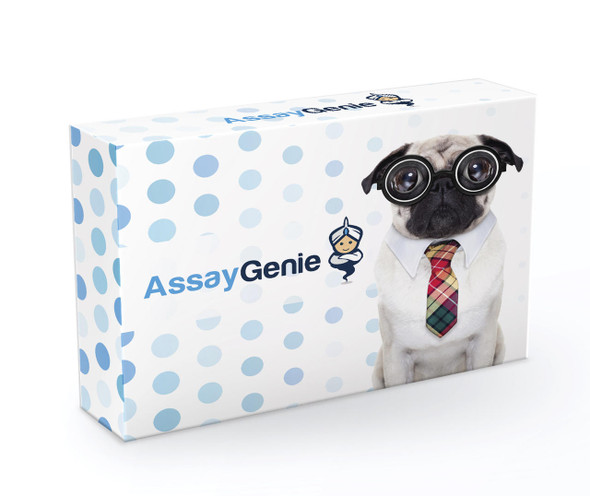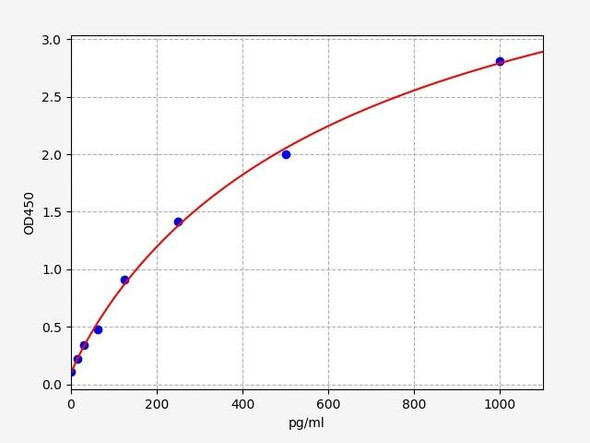Hamster IL-10 ELISA Kit (HMFI0003)
- SKU:
- HMFI0003
- Product Type:
- ELISA Kit
- Size:
- 96 Assays
- Uniprot:
- G3HB01
- Sensitivity:
- 3.75pg/ml
- Range:
- 6.25-400pg/ml
- ELISA Type:
- Sandwich
- Synonyms:
- IL-10, IL10, IL10A, CSIF, TGIF
- Reactivity:
- Hamster
Description
Hamster IL-10 ELISA
Interleukin-10 (IL-10) is a cytokine produced mostly by monocytes, macrophages and B cells, but also by other cell types such as mast cells, eosinophils, neutrophils and NK cells. IL-10 is used as a biomarker for inflammation and plays a key role in pathologies such as hepatitis, tuberculosis, multiple sclerosis and cancer. The Assay Genie Hamster IL-10 ELISA allows researchers to accurately measure IL-10 in hamster serum, blood, plasma, cell culture supernatant and tissue samples.
Key Features
| Save Time | Pre-coated 96 well plate | |
| Quick Start | Kit includes all necessary reagents | |
| Publication Ready | Reproducible and reliable results |
Overview
| Product Name: | Hamster IL-10 (Interleukin-10) ELISA Kit |
| Product Code: | HMFI0003 |
| Size: | 96 Assays |
| Target: | Hamster IL-10 |
| Alias: | IL10A, CSIF, TGIF |
| Reactivity: | Hamster |
| Detection Method: | Sandwich ELISA, Double Antibody |
| Sensitivity: | 3.75pg/ml |
| Range: | 6.25-400pg/ml |
| Storage: | 4°C for 6 months |
| Note: | For Research Use Only |
Additional Information
| Recovery | Please contact us for more information. |
| Linearity: | Please contact us for more information. |
| Intra-Assay: | CV <8% |
| Inter-Assay: | CV <10% |
Protocol
*Note: Protocols are specific to each batch/lot. For the correct instructions please follow the protocol included in your kit.
| Step | Procedure |
| 1. | Set standard, test sample and control (zero) wells on the pre-coated plate respectively, and then, record their positions. It is recommended to measure each standard and sample in duplicate. Wash plate 2 times before adding standard, sample and control (zero) wells! |
| 2. | Aliquot 0.1ml standard solutions into the standard wells. |
| 3. | Add 0.1 ml of Sample / Standard dilution buffer into the control (zero) well. |
| 4. | Add 0.1 ml of properly diluted sample ( Human serum, plasma, tissue homogenates and other biological fluids.) into test sample wells. |
| 5. | Seal the plate with a cover and incubate at 37 °C for 90 min. |
| 6. | Remove the cover and discard the plate content, clap the plate on the absorbent filter papers or other absorbent material. Do NOT let the wells completely dry at any time. Wash plate X2. |
| 7. | Add 0.1 ml of Biotin- detection antibody working solution into the above wells (standard, test sample & zero wells). Add the solution at the bottom of each well without touching the side wall. |
| 8. | Seal the plate with a cover and incubate at 37°C for 60 min. |
| 9. | Remove the cover, and wash plate 3 times with Wash buffer. Let wash buffer rest in wells for 1 min between each wash. |
| 10. | Add 0.1 ml of SABC working solution into each well, cover the plate and incubate at 37°C for 30 min. |
| 11. | Remove the cover and wash plate 5 times with Wash buffer, and each time let the wash buffer stay in the wells for 1-2 min. |
| 12. | Add 90 µl of TMB substrate into each well, cover the plate and incubate at 37°C in dark within 10-20 min. (Note: This incubation time is for reference use only, the optimal time should be determined by end user.) And the shades of blue can be seen in the first 3-4 wells (with most concentrated standard solutions), the other wells show no obvious color. |
| 13. | Add 50 µl of Stop solution into each well and mix thoroughly. The color changes into yellow immediately. |
| 14. | Read the O.D. absorbance at 450 nm in a microplate reader immediately after adding the stop solution. |
Sample Preparation
When carrying out an ELISA assay it is important to prepare your samples in order to achieve the best possible results. Below we have a list of procedures for the preparation of samples for different sample types.
| Sample Type | Protocol |
| Serum | If using serum separator tubes, allow samples to clot for 30 minutes at room temperature. Centrifuge for 10 minutes at 1,000x g. Collect the serum fraction and assay promptly or aliquot and store the samples at -80°C. Avoid multiple freeze-thaw cycles. If serum separator tubes are not being used, allow samples to clot overnight at 2-8°C. Centrifuge for 10 minutes at 1,000x g. Remove serum and assay promptly or aliquot and store the samples at -80°C. Avoid multiple freeze-thaw cycles. |
| Plasma | Collect plasma using EDTA or heparin as an anticoagulant. Centrifuge samples at 4°C for 15 mins at 1000 × g within 30 mins of collection. Collect the plasma fraction and assay promptly or aliquot and store the samples at -80°C. Avoid multiple freeze-thaw cycles. Note: Over haemolysed samples are not suitable for use with this kit. |
| Urine & Cerebrospinal Fluid | Collect the urine (mid-stream) in a sterile container, centrifuge for 20 mins at 2000-3000 rpm. Remove supernatant and assay immediately. If any precipitation is detected, repeat the centrifugation step. A similar protocol can be used for cerebrospinal fluid. |
| Cell culture supernatant | Collect the cell culture media by pipette, followed by centrifugation at 4°C for 20 mins at 1500 rpm. Collect the clear supernatant and assay immediately. |
| Cell lysates | Solubilize cells in lysis buffer and allow to sit on ice for 30 minutes. Centrifuge tubes at 14,000 x g for 5 minutes to remove insoluble material. Aliquot the supernatant into a new tube and discard the remaining whole cell extract. Quantify total protein concentration using a total protein assay. Assay immediately or aliquot and store at ≤ -20 °C. |
| Tissue homogenates | The preparation of tissue homogenates will vary depending upon tissue type. Rinse tissue with 1X PBS to remove excess blood & homogenize in 20ml of 1X PBS (including protease inhibitors) and store overnight at ≤ -20°C. Two freeze-thaw cycles are required to break the cell membranes. To further disrupt the cell membranes you can sonicate the samples. Centrifuge homogenates for 5 mins at 5000xg. Remove the supernatant and assay immediately or aliquot and store at -20°C or -80°C. |
| Tissue lysates | Rinse tissue with PBS, cut into 1-2 mm pieces, and homogenize with a tissue homogenizer in PBS. Add an equal volume of RIPA buffer containing protease inhibitors and lyse tissues at room temperature for 30 minutes with gentle agitation. Centrifuge to remove debris. Quantify total protein concentration using a total protein assay. Assay immediately or aliquot and store at ≤ -20 °C |
| Breast Milk | Collect milk samples and centrifuge at 10,000 x g for 60 min at 4°C. Aliquot the supernatant and assay. For long term use, store samples at -80°C. Minimize freeze/thaw cycles. |
Hamster IL-10 Background
IL-10 refers to Interleukin-10, which is a cytokine, a type of signaling molecule involved in the immune system's regulation and response. IL-10 is primarily produced by various immune cells, including T cells, B cells, macrophages, and dendritic cells. It plays a crucial role in modulating immune responses and promoting immune tolerance.
IL-10 Function
The primary function of IL-10 is to suppress inflammation and regulate immune responses. It accomplishes this through multiple mechanisms. IL-10 inhibits the production of pro-inflammatory cytokines such as IL-1, IL-6, and TNF-alpha, thereby reducing the overall inflammatory response. Additionally, IL-10 dampens the activity of immune cells involved in inflammation, including macrophages and dendritic cells, leading to a more controlled immune response. Moreover, IL-10 promotes immune tolerance, downregulating the reactivity of the immune system to self-antigens and preventing autoimmune diseases. Furthermore, IL-10 exhibits anti-tumor effects and plays a role in tissue repair processes, highlighting its diverse functions within the immune system.
IL-10 inflammation
As an anti-inflammatory cytokine, IL-10 acts as a key suppressor, mitigating the inflammatory response and preventing excessive tissue damage. It achieves this by inhibiting the production of pro-inflammatory cytokines, effectively reducing the overall inflammation. Additionally, IL-10 suppresses the activity of immune cells involved in inflammation, such as macrophages and dendritic cells, leading to a more controlled and balanced immune response. Through its regulatory effects, IL-10 helps maintain immune homeostasis and prevents the development of chronic inflammation.
Hamster IL-10 FAQs
What is the Hamster IL-10 ELISA Kit?
The Hamster IL-10 ELISA Kit is a specialized assay kit designed to detect and quantify IL-10 levels in biological samples.
What are the advantages of using the Hamster IL-10 ELISA Kit?
The Hamster IL-10 ELISA Kit offers several advantages for researchers. It provides accurate and quantitative measurements of IL-10 levels in hamster samples, enabling precise analysis of immune responses. The kit is user-friendly, offering a straightforward procedure and providing reliable results within a short time frame. With its specificity for hamster IL-10, researchers can confidently study IL-10-related processes in hamsters using this kit.
Where can I find more information about the Hamster IL-10 ELISA Kit?
For more detailed information about the Hamster IL-10 ELISA Kit, including technical specifications, performance characteristics, and ordering details, please refer to the product brochure or contact our customer support team. We are here to assist you with any inquiries you may have.







